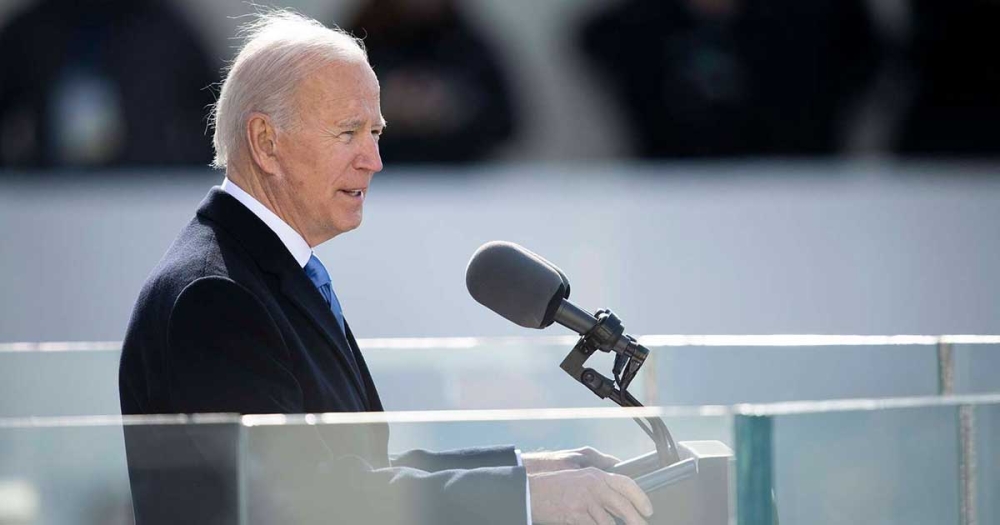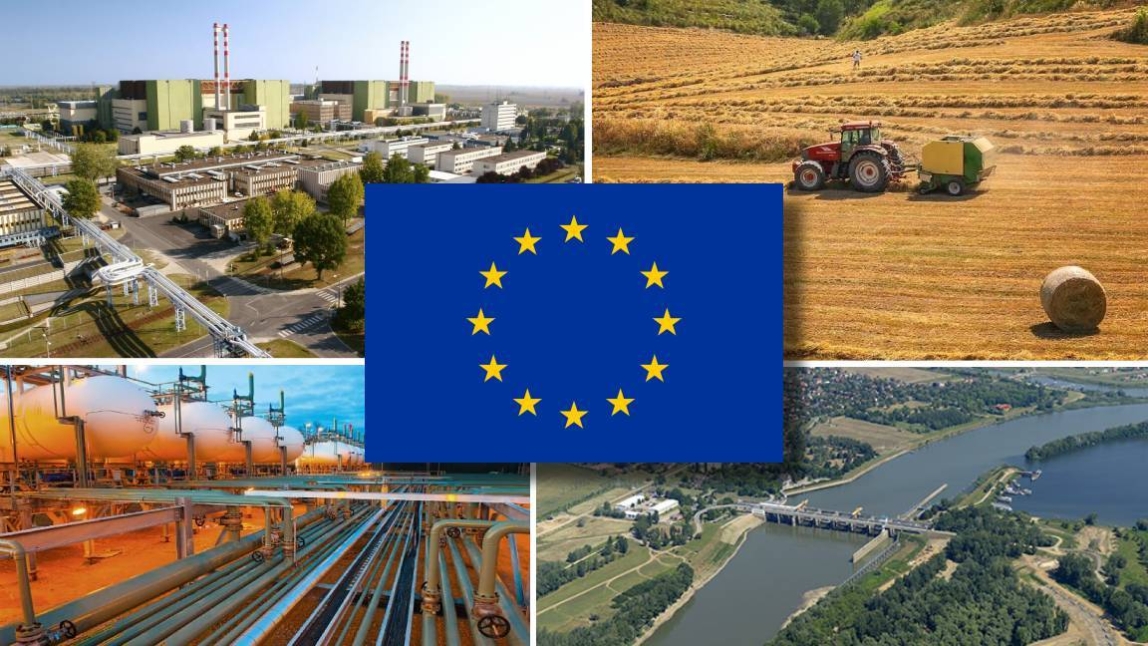What does President Biden’s landmark Inflation Reduction Act mean in terms of climate change?
U.S. President Joe Biden aims to build a future for clean energy in America that creates high-paying jobs, reduces energy costs and successfully mitigates climate change. The Inflation Reduction Act, abbreviated IRA, has been described as “the most significant action Congress has taken on clean energy and climate change in the nation’s history” and takes major steps toward modernizing the American economy and reducing dependency on fossil fuels. The law allocates a total of $437 billion of the U.S. budget, of which $369 billion is earmarked for emission reduction measures, renewable energy and climate resilience.
The Inflation Reduction Act and its expected effect on greenhouse gas emissions in the United States is described in the following.
1. How was the Inflation Reduction Act conceived?
The agreement was reached as a result of months of negotiations. Republicans refused to support the bill, while Democrats put increasing pressure on Biden to declare a climate emergency. On 7 August 2022, the bill was approved by the Senate and finally sent to Congress. In terms of budget, the Act is a far cry from previous proposals put forward by the administration, but nevertheless brings the U.S. closer to meeting international climate targets.
2. What climate and energy policy-related measures are included in the Act?
The bill includes a total of $437 billion in “investments”, 85 percent of which will be used to cut back on emissions and address the projected impacts of climate change, with the remainder going to expand the Affordable Care Act. Measures aimed at improving energy security and reducing emissions will come primarily from grants, loans and tax credits.
2.1. Low-carbon energy
The Biden administration seeks to decarbonize the energy sector by 2035. Solar energy is central to decarbonizing power generation. In essence, the legislation features a 10-year extension of the 30 percent investment tax credit for commercial and residential projects, including those launched in 2022. For larger solar projects above 1 MW, the default tax credit will be 6 percent.
To qualify for the additional 24 percent, workers and mechanics installing the solar panels must be paid the wages due under current U.S. regulations. An additional 10 percent is added for a specific amount of domestically produced content and installment in specific locations, as well as further credit for clean energy production. In summary, the solar industry is prioritizing workers’ needs, legal employment and standards-based wages while maintaining steady growth.
According to a Rhodium Group study, the share of electricity generated by renewables and nuclear power plants in the U.S. may even double in the current decade, increasing from 40 percent in 2021 to 60-81 percent by 2030. The climate package also provides incentives for battery storage and biogas, similar to the tax credits for wind and solar investments. It also provides new or modified tax incentives for nuclear energy and clean hydrogen, as well as carbon capture and storage (CCS).
Additional tax credits are provided for the domestic production of sustainable aviation fuels and other biofuels, as well as for the development of the necessary infrastructure. The Act provides for a targeted grant and loan program for state-owned and electric power plants to accelerate the transition to clean energy; it also earmarks $27 billion for a nationwide “green bank” to support the deployment of clear technologies, particularly in underdeveloped areas.
2.2. Low-emission technologies for household use
The Act incentivizes the household use of low-carbon energies, including energy efficiency retrofits and a ten-year consumer tax credit for the installation of heat pumps and rooftop solar panels.
2.3. E-mobility
The Inflation Reduction Act provides tax credits for low and middle-income earners to encourage the purchase of both used and newly made low-emission vehicles over the period leading up to 2032. The bill also removed the cap of 200,000 vehicle sales eligible for the tax credit, which previously meant that manufacturers such as Tesla and General Motors could no longer sell cars with the incentive if they exceeded this limit. The measures include clauses designed to exclude mineral substances and components originating from certain countries, notably China, which currently supplies the vast majority of U.S. imports of these materials.
Price reductions have also been put in place, meaning that companies producing models priced at over $55,000 will not be eligible for credits. This criterion is currently met by fifteen models, but manufacturers will have to make additional changes to meet the requirements for sourcing batteries made in North America.
The Inflation Reduction Act also supports the U.S. Postal Service in the purchase of zero-emission vehicles and covers the additional cost of low-carbon heavy-duty vehicles, including buses and garbage trucks.
2.4. Fossil fuels
Environmentalist groups are highly concerned about the part of the Act that could result in increased oil and gas production of public lands and seas. This issue has previously elicited mixed feelings from Senate climate justice advocates and runs counter to President Biden’s promise on his first day in office to end new oil and gas drillings on federal lands. Additionally, the International Energy Agency (IEA) has concluded that no new fossil fuel investments are needed if the world is to move toward net zero carbon emissions by 2050.
However, the Act also includes elements serving climate protection and contains several provisions that could curb emissions produced by the fossil fuel industry. It includes a methane emission reduction scheme to reduce leakages from gas extraction and distribution, offers grants and loans to producers, and imposes taxes on over-emitters. In a broader sense, the Inflation Reduction Act includes an increase in concession fees to be paid by companies wishing to extract oil and gas from public-owned lands and seas.
2.5. Industry and production
There is particular emphasis on supporting the domestic production of low-carbon technologies such as solar panels, wind turbines, batteries and the processing of critical minerals, which will be covered by tax incentives for industrial production. For the electric vehicle industry, the Inflation Reduction Act will provide credit for the construction of new facilities and the transition to low-carbon vehicle production in existing plants. In addition, $500 million has been made available to implement programs approved by the Defense Production Act, which authorizes the President to direct private corporations in the event of a national emergency.
President Biden has previously invoked this right to accelerate the production of key technologies, including heat pumps. A new industrial development scheme has been established to help cut emissions from heavy industry – one of the most difficult sectors to decarbonize – by assisting the funding of, e.g., energy efficiency improvements. Finally, national laboratories will receive support to accelerate breakthrough research on energy.
In September 2022, the Biden-Harris administration announced new measures under the Federal Buy Clean Initiative in order to encourage the purchase of low-carbon steel, concrete, asphalt and flat glass. Combined, the production of these materials accounts for almost half of all greenhouse gas emissions in the U.S.
2.6. Climate justice
The Act provides unprecedented levels of funding for underprivileged communities severely affected by pollution and the impacts of climate change. Sources of funding include environmental and climate justice grants to local governments, Native American tribes and local communities to address environmental concerns in their areas. Grants are also available to develop affordable transport options, connect communities divided by highways and improve air quality in harbors by covering the cost of zero-emission equipment.
2.7. Agriculture
The Inflation Reduction Act supports Climate-Smart Agriculture (CSA) practices aimed at mitigating climate change, as well as forest protection, urban tree planting and coastal habitat conservation and restoration. The project announced by the Biden-Harris administration is of historical significance and is poised to have a major impact on climate-conscious farmers and communities worldwide.
The United States Department of Agriculture (USDA) is committed to supporting a broad range of farmers, ranchers and private forest owners through its 70 model projects under the so-called Partnership for Climate-Smart Commodities, thereby expanding the market for such products. The projects, lasting one to five years, are expected to result in the sequestration of at least 50 million tons of carbon dioxide equivalents, with progress monitored and verified by universities.
3. How much could the United States reduce its emissions?
According to a study authored in the framework of the Rapid Energy Policy Evaluation and Analysis Toolkit (REPEAT) project, the Inflation Reduction Act could result in 42 percent lower GHG emissions by 2030 compared to 2005 levels. This projection is in line with Democratic senators’ previous vision. Other papers have arrived at different estimates regarding future emission levels. According to the Rhodium Group, the act could result in 32-42 percent lower emissions by 2030 compared to 2005, while Energy Innovation projected a 37-41 percent reduction.
In our view, the wide range of projected emissions reflects uncertainty about economic growth, the high cost of clean technologies and the price of fossil fuels. Further action at governmental level would be needed to halve emissions by 2030 compared to 2005 levels, which is the international target set by the U.S. under the Paris Agreement.
As shown in the REPEAT chart below (Figure 1), the Inflation Reduction Act (purple) represents a significant improvement over the current policy situation (red). Even if we take into account the climate protection provisions of the Infrastructure Investment and Jobs Act, passed in late 2020, the U.S. is expected to reduce its GHG emissions by only 27 percent until 2030 compared to 2005 levels. This is barely halfway toward the climate protection target. Overall, research carried out under the REPEAT project concludes that the new bill closes about two-thirds of the gap between current policy and the 2030 climate target.

Figure 1: Historical (black) and projected (color) net U.S. GHG emissions, including soil-based carbon sinks. The horizontal line indicates the U.S. target for 2030 under the Paris Agreement. Source: REPEAT Project
4. What are the differences compared to Biden’s previous climate policy?
The Inflation Reduction Act has a significantly smaller budget than the original $3.5 trillion Build Back Better Act, proposed by Biden last year and passed by the U.S. House of Representatives in November 2021. However, Build Back Better failed to pass the Senate. According to The New York Times, the original proposal called for the creation of a civilian climate panel, restrictions on offshore drilling and an effort to steer people and communities toward wind and solar power. The final version of the bill is the biggest investment the U.S. has ever made in the fight against climate change and could set an example for the rest of the world. However, it is still far short of what the Democrats originally wanted.
Although the United States considers itself a leader in global climate protection, it has been pursuing a rather turbulent climate policy over the past decade. One year after the Paris Agreement being signed in 2016, President Trump announced the withdrawal of his country from the Accords. The U.S. rejoined the international treaty only in 2021. Furthermore, results of the U.S. midterm elections show that despite the Inflation Reduction Act, President Biden’s approval rating has been steadily declining. The Act has been widely criticized for leading to a much larger national budget than previously expected.
Because many financial incentives are “unlimited” – i.e., lack an upper budget limit –, climate spending is expected to reach up to $1 billion. Thus, the government is obliged to provide these as long as corporations and individuals meet the criteria set for them, which could lead to overspending in extreme cases




